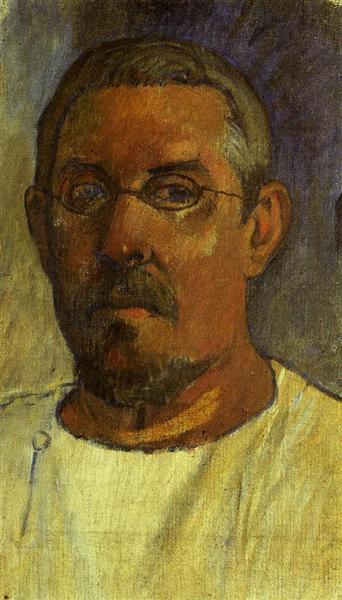Descrizione
L'opera "auto -portrait con gli occhiali" di Paul Gauguin, realizzato nel 1903, è registrato in un periodo particolarmente introspettivo della vita dell'artista, che coincide con gli ultimi anni della sua esistenza. Questo dipinto non è solo presentato come una semplice rappresentazione dell'autore, ma viene eretta come una meditazione sull'identità, la percezione e la solitudine del Creatore. Gaugin, noto per il suo stile postimpressionista e il suo uso innovativo del colore, si applica in questo auto -portrait una tavolozza che è caratteristica della sua evoluzione artistica, ricca di sfumature e simbolismo.
Al centro della tela, il volto di Gauguin si svolge con una forza che attira immediatamente lo sguardo dello spettatore. Le caratteristiche del pittore, con un angolo leggermente a tre quartieri, sono delineate con tratti fermi e un parto quasi emotivo alla loro rappresentazione. Gli occhiali che adornano il loro viso non sono semplicemente un accessorio, ma sembrano simboleggiare uno sguardo critico verso il mondo circostante, una dualità tra l'osservatore e l'osservazione. Il modo in cui l'artista si presenta con gli occhiali può essere interpretato come una metafora della sua visione di arte e vita: un tentativo di focalizzare e capire ciò che lo circonda, mentre, allo stesso tempo, c'è una barriera tra lui e l'esterno mondo.
La composizione è notevole non solo per la sua attenzione sul viso, ma anche per il modo in cui gli elementi dello sfondo e l'abbigliamento dell'artista completano la sua figura centrale. Gauguin usa uno sfondo di toni scuri che contrastano con i colori più caldi della sua pelle e il capo che hai visto. Questo uso del colore, in cui ocra si combina con il blu, crea un'atmosfera che è sia intima che malinconica. L'artista mostra la sua padronanza nella gestione dei colori complementari, generando così un effetto vibrante che migliora la profondità emotiva del lavoro.
È essenziale considerare che "auto -portrait con gli occhiali" si verifica in un contesto di riflessione personale e artistica. Nel 1903, Gauguin aveva già fatto il suo viaggio a Tahiti, che aveva avuto una profonda influenza sul suo lavoro, ma si trovava in una fase in cui la nostalgia e il desiderio di bellezza avevano un ruolo fondamentale. Questo auto -portrait, come molte delle sue opere di questa era, rivela la sua costante ricerca di un significato più profondo, un senso di appartenenza che molte volte sembrava sfuggente.
Inoltre, questo quadro presenta interessi tematici che risuonano in altri pezzi del loro repertorio, dove diventa evidente l'attenzione sull'esplorazione introspettiva e sullo stile di vita dell'artista. In termini di opere contemporanee, possono essere stabiliti affascinanti dialoghi con gli auto -portrai di Vincent Van Gogh e altri artisti della stessa era, che hanno anche esplorato le proprie identità attraverso la tela. Tuttavia, l'approccio di Gauguin si distingue da un colore più audace e da una rappresentazione più simbolica dell'essere, che indica una ricerca non solo della forma, ma dell'essenza.
"Auto -portrait con gli occhiali" incapsula parte integrante della vita di Gauguin e della sua eredità artistica. È un lavoro che combina il dominio tecnico con un intenso onere emotivo, invitando lo spettatore a riflettere sulla natura dell'arte e dell'esperienza umana. In questo senso, l'opera non è solo una rappresentazione dell'autore, ma un manifesto della sua visione del mondo, un invito a guardare oltre la superficie e affrontare le verità più profonde che sono alla base di essere umani. Pertanto, questo auto -portrait diventa uno specchio che non solo riflette l'artista, ma consente anche a ogni spettatore di contemplare il proprio look verso l'arte e la vita.
KUADROS ©, una famosa vernice sul muro.
Dipinti ad olio fatti a mano, con la qualità degli artisti professionisti e il distintivo sigillo di KUADROS ©.
Servizio di riproduzione delle immagini con garanzia di soddisfazione. Se non sei completamente soddisfatto della replica del tuo dipinto, rimborsiamo i tuoi soldi al 100%.

